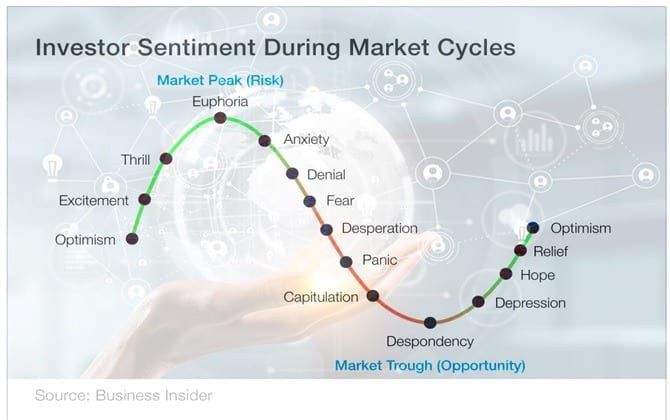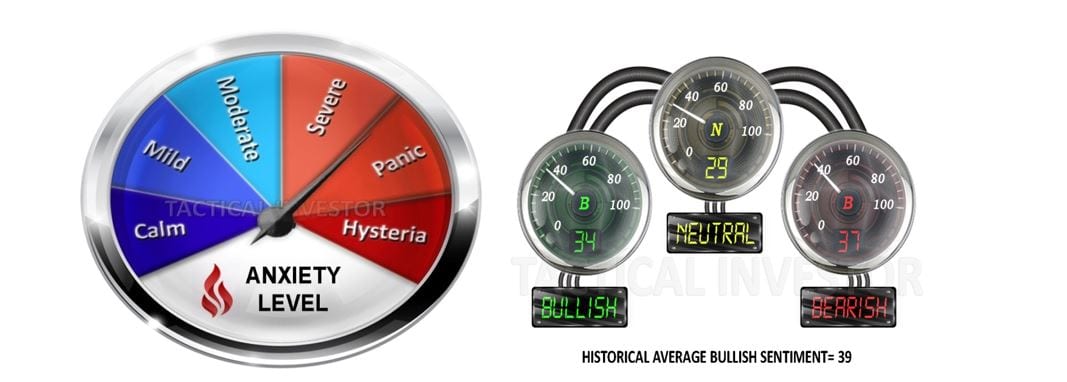Investor Psychology Cycle: Forge Your Path
Dec 12, 2024
Some would liken today’s markets to Elon Musk; the guy is erratic, and TSLA’s inconsistent stock price action validates this point. However, comparing the stock market to Elon Musk, the CEO of Tesla, is an oversimplification and does not accurately capture the intricacies of the financial world.
While it is true that Elon Musk’s behaviour has been erratic at times, this does not necessarily correlate to the behaviour of the stock market as a whole. Furthermore, while Tesla’s stock price has been volatile, it is essential to note that the company is a disruptor in the automotive industry and is pushing previously thought impossible boundaries.
Additionally, suggesting that one should short Tesla’s stock based solely on its CEO’s behaviour is risky and can result in significant losses. As evidenced by the recent losses of short sellers, betting against the market can prove a costly mistake.
Instead, please focus on the psychological state of the masses when it comes to the market. In the case of Tesla, the stock has a cult-like following, and bad news has not significantly impacted its price. Applying Mass Psychology to this situation would have yielded better results and prevented losses.

Investor sentiment and Market Cycles
This chart does an excellent job of reflecting the mass mindset regarding the market. However, it is interesting to note that despite its accuracy, very few individuals or organizations use this valuable information.
The Wall Street Journal recently reported a record $3.4 trillion in cash sitting on the sidelines, waiting to be invested in the market. While this influx of money will undoubtedly push markets higher, it is more important to note that the crowd is still far from bullish. Looking at the sentiment below, it is clear that there is no consistency in bullish sentiment, as it has not remained above 60% for three consecutive weeks in years.
We cannot recall seeing sentiment above 60% for three weeks in a row since the beginning of this bull market, and this is a telling development indeed.
Investors must pay close attention to this lack of consistency in bullish sentiment and act accordingly. While there is undoubtedly money to be made in the market, it is essential to approach investing cautiously and consider the psychology of the masses before making any decisions.
This sentiment data was tabulated before Friday’s sell-off; therefore, it appears that the crowd was already spooked before Friday’s sell-off, further cementing the view that a sharp pullback has to be viewed as a blessing in disguise. Market Update Jan 31, 2020
The current sentiment data remains unchanged in bearish readings, but there has been a slight rise in bullish readings compared to the previous update. This seems to be a contradiction; the crowd initially panicked, then turned bullish, resulting in a surge in the market to new highs, yet the bears still seem to dominate. This inconsistency highlights that the central theme dominating the masses is still uncertainty. As investors, it is essential to take note of this and approach the market cautiously.
Investor Psychology: March 2023 update
As we wrap up 2022, the markets managed their best action in about three weeks on Wednesday due to oversold technical conditions and anticipation of a Santa Claus rally attracting buyers. However, market players remain skittish as they digest a slew of gloomy market forecasts for 2023, which has resulted in elevated volatility and some random movement. Mass psychology indicates that the best time to invest in the market is when the masses are in disarray or panic. This makes me hopeful for some short-term relief during the Santa rally period.
The Santa rally, historically starting the day before the Christmas holiday and lasting until the end of the year, is marked by higher bouts of volatility.
According to a survey released on Monday, wealthy investors expect this year’s stock market nightmare to worsen in 2023, with most predicting a US recession. Bearish sentiment has hit its highest level since the Great Recession, with 56% of millionaire investors anticipating the S&P 500 will post a double-digit loss next year. The gloomy outlook reflects mounting fears on Wall Street that a year of sharp interest rate hikes by the Federal Reserve will topple the US economy into a recession.
Solid majorities in a new survey by State Street Global Advisors say they are worried about ongoing market volatility and inflation, with nearly three-quarters of respondents saying they are concerned about inflation. Sixty-four per cent of respondents expect that stock market volatility will persist for at least another year. While passive funds and ETFs won’t wholly supplant active managers, their market share will continue to rise.
Despite the market’s uncertainty and negative outlook, two-thirds of investors in the latest MLIV Pulse survey believe that holding cash in their portfolios will bolster their performance in the year ahead. Uncertainty presents opportunities for strategic investments, and mass psychology supports investing when the masses are uncertain.
Exploiting the Herd: Profiting from Market Extremes
Investing, understanding and leveraging mass psychology can be your secret weapon. The lemming syndrome, where investors blindly follow the crowd off the proverbial cliff, creates both peril and opportunity for the astute trader. Let’s explore how to use this phenomenon to your advantage.
Spotting Opportunities in Crashes
Market crashes are breeding grounds for irrational behaviour. As fear grips the masses, prices often plummet far below intrinsic values, creating golden opportunities for contrarian investors. Here’s how to capitalize on these moments:
1. Monitor Sentiment Indicators: Closely monitor indicators like the VIX (fear index) and put/call ratios. Extreme readings often signal market bottoms.
2. Look for Capitulation: Massive volume spikes coupled with sharp price declines can indicate panic selling, often marking the end of a downtrend.
3. Identify Positive Divergences: When prices make new lows but technical indicators like the MACD don’t, it can signal a potential reversal.
Real-World Example: March 2020 COVID Crash
During the COVID-19 market crash, the S&P 500 plummeted 34% in 23 trading days. As panic peaked in late March:
– The VIX hit an all-time high of 82.69 on March 16, 2020.
– The CBOE put/call ratio reached 1.28 on March 17, indicating extreme bearishness.
– Despite lower price lows, the MACD histogram showed positive divergence on the daily chart.
Investors who recognized these signals and bought near the bottom on March 23, 2020, would have seen their investments double in just over a year.
Selling at Tops: Recognizing Euphoria
Just as fear creates buying opportunities, euphoria signals potential selling points. Here’s how to spot market tops:
1. Watch for Excessive Optimism: When everyone is bullish, there’s no one left to buy. Look for extreme readings in sentiment surveys like the AAII Investor Sentiment Survey.
2. Identify Negative Divergences: When prices make new highs but technical indicators don’t confirm, it can signal weakening momentum.
3. Monitor Valuation Metrics: Extremely high P/E ratios or other valuation metrics across the market can indicate irrational exuberance.
Real-World Example: Dot-com Bubble
The dot-com bubble of the late 1990s provides a textbook example of market euphoria:
– The NASDAQ Composite P/E ratio reached an astronomical 175 in March 2000.
– Despite continued price increases, the MACD showed bearish divergence on the monthly chart throughout 1999.
– Investor optimism reached extreme levels, with the percentage of bullish investors in the AAII survey hitting 75% in January 2000.
Investors who recognized these signs of irrational exuberance and sold near the peak could have avoided the subsequent 78% crash in the NASDAQ Composite.
Implementing the Strategy
To effectively use this approach:
1. Develop a Contrarian Mindset: Train yourself to be sceptical when everyone else is hopeful and when others are fearful.
2. Use Multiple Indicators: Combine sentiment indicators, technical analysis, and fundamental valuation metrics for a comprehensive view.
3. Scale In and Out: Instead of trying to pick exact tops and bottoms, gradually build positions during crashes and reduce exposure as euphoria builds.
4. Stay Disciplined: Stick to your strategy even when your emotions or the crowd tells you otherwise.
By mastering the art of reading investor psychology and the Lemming syndrome, you can position yourself to profit from market extremes while others fall victim to their own emotions.
Conclusion: Investor Psychology Cycle
We firmly believe that investors with a long-term view should view sharp market corrections through a bullish lens. History has shown that markets tend to revert to the mean, meaning that when fear subsides, markets typically resume their upward trend. Despite the massive sell-off driven by fear, the trend remains positive, according to our Trend Indicator. Therefore, Tactical Investors should view sharp pullbacks as potential buying opportunities.
Today, market problems are exacerbated by so-called weaponized news. Sensationalized media coverage can trigger irrational fear among the masses, leading to panicked selling and a sharp market downturn. As an investor, staying informed is essential, but it’s equally important to remain level-headed and not let emotions guide investment decisions.
Remember, mass psychology suggests that the best time to invest in the market is when the masses are in disarray or panic. Investors can achieve better returns in the long run by keeping a long-term view and taking advantage of market corrections.
Other Articles of Interest












